please give summary of the article I really need for class!!!! thank you!!! ...
80.2K
Verified Solution
Question
Finance
please give summary of the article I really need for class!!!! thank you!!! 
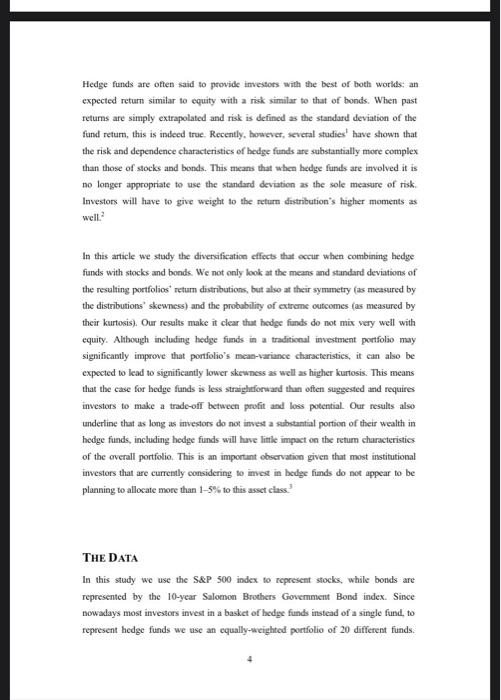
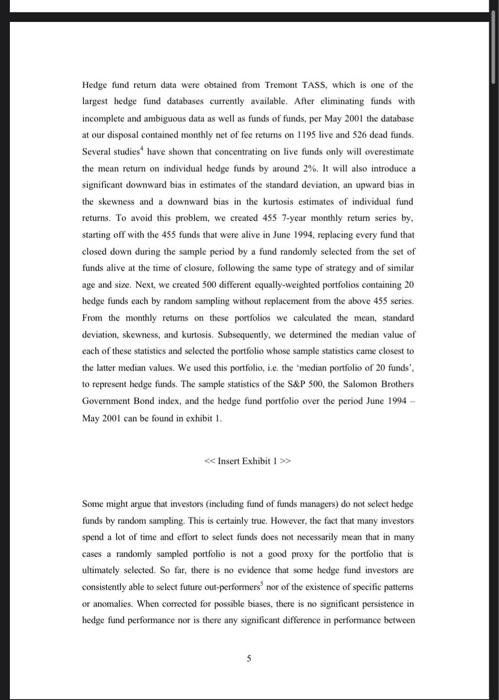
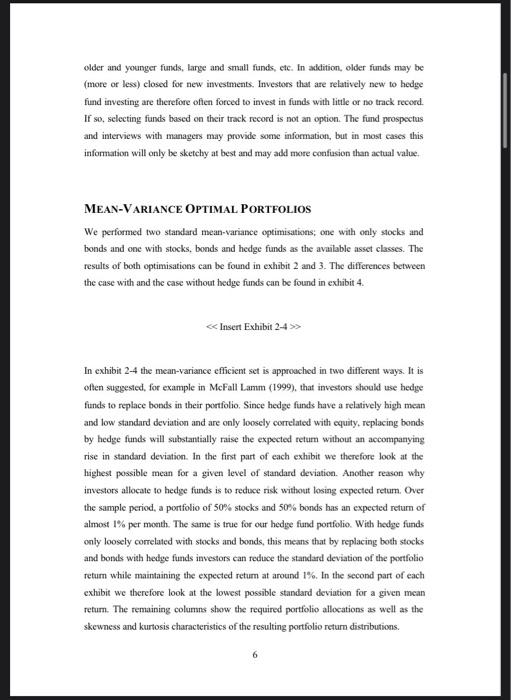
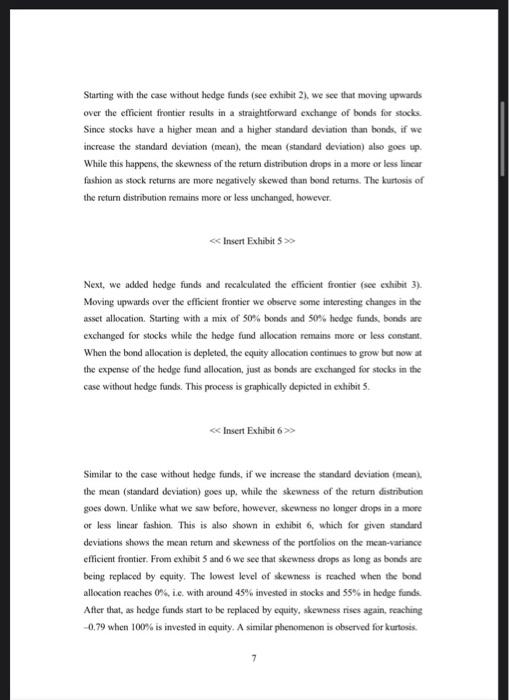
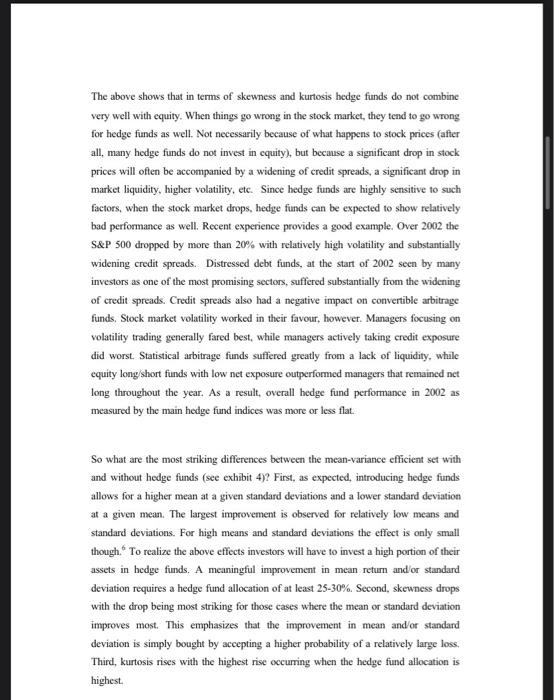 ABSTRACT We study the diversification effects from introducing hedge funds into a portfolio of stocks and bonds. Our results show that in terms of skewness and kurtosis equity and bedge funds do not combine very well. Although the inclusion of bedge funds significantly improves the portfolio's mean-variance characteristics, it can also be expected to lead to significantly lower skewness as well as higher kurtosis. This means that the case for hedge funds is not a free lunch but includes a definite trade-off between profit and loss potential. Our results also emphasize that to have at least some impact on the overall portfotio, investors will have to make an allocation to hedge funds which by far exceeds the typical 15% that many institutions are currently considering. Hedge funds are often said to provide imvestors with the best of both worlds: an expected return similar to equity with a risk similar to that of bonds. When past retums are simply extrapolated and risk is defined as the standard deviation of the fund return, this is indecd true. Recently, bowcver, scveral studies' have shown that the risk and dependence characteristics of bedge funds are substantially more complex than those of stocks and bonds. This means that when hedge funds are involved it is no longer appropriate to ase the standard deviation as the sole measure of risk. lnvestors will have to give weight to the return distribution's hagher moments as well. 2 In this article we study the diversification cffects that occur when combining hedge funds with stocks and bondk. We not only look at the means and standard deviations of the resulting portfolios' retum distributions, but also at their symmetry (as measured by the distributions' skewness) and the probubility of extreme outcomes (as measured by their kurtosis). Our resalts make it clear that bodge funds do not mix very well with equity. Although including hedge funds in a traditional investment portfolio may significantly improve that portfolio's mean-tariance characteristics, it can also be expected to lead to significantly lower skewness as well as higher kurtosis. This means that the case for bedge funds is less straigheforward than often suggested and requires investors to make a trade-ofl betueen profit and loss potential. Our restilts also underline that as long as imestors do not imvest a substantial portion of their wealth in hedge funds, including hedge funds will have little impact on the retum charscteristies of the overall portfolio. This is an important observation given that most institutional investors that are cumently considering to imvest in bedge fiands do not appear to be planning to allocate more than 15% to this asset chas. 3 THE DATA In this study we use the SRP 500 index to represent stocks, while bonds are represented by the 10-year Salomon Brothers Govemment Bond index. Since nowadays most investors invest in a basket of hedge funds intstead of a single fund, to represent hedge funds we use an equally-weighted portfolio of 20 different funds. Hedge fand retum data were obtained from Tremont TASS, which is one of the largest hedge fund databases currently available. After eliminating funds with incomplete and ambiguous data as well as funds of funds, per May 2001 the database at our disposal contained monthly net of foe retums on 1195 live and 526 dead funds. Several studies 4 have sbown that concentrating on live funds only will overestimate the mean retum on individual bedge funds by around 2%. It will also introduce a significant downward bias in estimates of the standard deviation, an upward bias in the skewness and a downward bias in the kurtosis estimates of individual fund returns. To avoid this problem, we created 455 7-year monthly retum series by, starting off with the 455 funds that were alive in June 1994, replacing every fund that closed down during the sample period by a fund randomly selected from the set of funds alive at the time of closure, following the same type of strategy and of similar age and size. Next, we created 500 different equally-weighted portfolios containing 20 hedge funds each by random sampling without replacement from the above 455 series. From the monthly retums on these portfolios we calculated the mean, standard deviation, skewness, and kurtosis. Subsequently, we determined the median value of each of these statisties and selected the portfolio whose sample statistics came closest to the latter medan values. We tsed this portfolio, i.e. the 'median portfolio of 20 funds', to represent hedge funds. The sample statistics of the S\&P 500 , the Salomon Brothers Govemment Bond index, and the hedge fund portfolio over the period June 1994 May 2001 can be found in exhibit 1. > Soone might argue that investors (including fund of funds managers) do not select hedge funds by rundom sampling. This is certainly true. However, the fact that many investors spend a lot of time and effort to select funds does not necessarily mean that in many cases a randomly sampled portfolio is not a good proxy for the portfolio that is ulimately selected. So far, there is no evidence that some hedge fund investors are consistently able to select future out-perforners 3 nor of the existence of specific pattems or anomalies. When corrected for possible biases, there is no significant persistence in hedge fund performance nor is there any significant difference in performance between older and younger funds, large and small funds, etc. In addition, older funds may be (more or less) closed for new investments. Investors that are relatively new to hedge fund investing are therefore oflen forced to invest in funds with little or no track record. If so, selecting funds based on their track record is not an option. The fund prospectus and interviews with managers may provide some information, but in most cases this information will only be sketchy at best and may add more confision than actual value. MEAN-VARIANCE OPTIMAL PORTFOLIOS We performed two standard mean-variance optimisations; one with oaly slocks and bonds and one with stocks, bonds and hedge funds as the available asset classes. The results of both optimisations can be found in exhibit 2 and 3 . The differences between the case with and the case without hedge funds can be found in exhibit 4 . Insert Exhibit 24>> In exhibit 2-4 the mean-variance efficient set is approached in two different ways. It is often suggested, for example in McFall Lamm (1999), that investors should use bedge funds to replace bonds in their portfolio. Since hedge funds have a relatively high mean and low standard deviation and are only loosely correlated with equity, replacing bonds by hedge funds will substantially raise the expected retum without an accompanying rise in standard deviation. In the first part of each exhibit we therefore look at the highest possible mean for a given level of standard deviation. Another reason why investors allocate to hedge funds is to reduce risk without losing expected retum. Over the sample period, a portfolio of 50% stocks and 50% bonds has an expected return of almost 1% per month. The same is true for our hedge fund portfolio. With hedge funds only loosely correlated with stocks and bonds, this means that by replacing both stocks and bonds with hedge funds investors can reduce the standard deviation of the portfolio return while maintaining the expected return at around 1%. In the second part of each exhibit we therefore look at the lowest possible standard deviation for a given mean return. The remaining columns show the required portfolio allocations as well as the skewness and kurtosis characteristics of the resulting portfolio return distributions. Starting with the case without hedge funds (see exhibit 2), we see that moving upwards over the efficient frontier results in a straightfonward exchange of bonds for stocks. Since stocks have a higher mean and a higher standard deviation than bonak, if we increase the standard deviation (mean), the mean (standard deviation) also goes tep. While this happens, the skewness of the retum distribution drops in a more or less linear fashion as stock returns are more negatively skewed than bond returns. The kurtosis of the return distribution remains more or less unchanged, however. 0 Next, we added hedge funds and recakculated the efficient frontier (see exhibit 3). Moving upwards over the efficient frontier we observe some interesting changes in the asset allocation. Starting with a mix of 50% bonds and 50% hedge funds, bonds are exchanged for stocks while the hedge fund allocation remains more or less constant. When the bond allocation is depleted, the equity allocation contimues to grow bot now at the expense of the hedge fund allocation, just as bonds are exchanged for stocks in the case without hedge funds. This process is graphically depicted in exhibit 5. > Similar to the case withoun hedge funds, if we increase the standard deviation (mean). the mean (standard deviation) goes up, while the skewness of the return distribution goes down. Unlike what we saw before, however, skewness no longer drops in a more or less linear fastion. This is also shown in exbibit 6 , which for given standerd deviations shows the mean retum and skewness of the pontfolios on the mean-variance efficient frontier. From exhibit 5 and 6 we see that skewness drops as long as bonds are being replaced by equity. The lowest level of acwness is reached when the bond allocation reaches 0%, i.c. with around 45% invested in stocks and 55% in bedge funds. After that, as hedge funds start to be replaced by equity, skewness rives again, reaching -0.79 when 100% is invested in cquity. A similar phenomenon is observed for kurtosis The above shows that in terms of skewness and kurtosis bedge funds do not combine very well with equity. When things go wrong in the stock market, they tend to go wrong for hedge funds as well. Not necessarily because of what happens to stock prices (after all, many hedge funds do not invest in equity), but because a significant drop in stock prices will often be accompanied by a widening of credit spreads, a significant drop in market liquidity, higher volatility, etc. Since hedge funds are highly sensitive to such factors, when the stock market drops, hedge funds can be expected to show relatively bad performance as well. Recent experience provides a good example. Over 2002 the S\&P 500 dropped by more than 20% with relatively high volatility and substantially widening credit spreads. Distressed debt funds, at the start of 2002 seen by many investors as one of the most promising sectors, suffered substantially from the widening of credit spreads. Credit spreads also had a negative impact on convertible arbitrage funds, Stock market volatility worked in their favour, however. Managers focusing on volatility trading generally fared best, while managers actively taking credit exposure did worst. Statistical arbitrage funds suffered greatly from a lack of liquidity, whilc equity long/short funds with low net exposure outperformed managers that remained net long throughout the year. As a result, overall hedge fund performance in 2002 as measured by the main hedge fund indices was more or less flat. So what are the most striking differences between the mean-variance efficient set with and without hedge funds (see exhibit 4 )? First, as expected, introducing hedge funds allows for a higher mean at a given standard deviations and a lower standard deviation at a given mean. The largest improvement is observed for relatively low means and standard deviations. For high means and standard deviations the effect is only small though, 6 To realize the above effects investors will have to invest a high portion of their assets in hedge fuuds. A meaningful improvement in mean return andlor standard deviation requires a hedge fund allocation of at least 25-30\%. Second, skewness drops with the drop being most striking for those cases where the mean or standard deviation improves most. This emphasizes that the improvement in mean and/or standand deviation is simply bought by accepting a higher probability of a relatively large loss. Third, kurtosis rises with the highest rise occurning when the bedge fund allocation is highest
ABSTRACT We study the diversification effects from introducing hedge funds into a portfolio of stocks and bonds. Our results show that in terms of skewness and kurtosis equity and bedge funds do not combine very well. Although the inclusion of bedge funds significantly improves the portfolio's mean-variance characteristics, it can also be expected to lead to significantly lower skewness as well as higher kurtosis. This means that the case for hedge funds is not a free lunch but includes a definite trade-off between profit and loss potential. Our results also emphasize that to have at least some impact on the overall portfotio, investors will have to make an allocation to hedge funds which by far exceeds the typical 15% that many institutions are currently considering. Hedge funds are often said to provide imvestors with the best of both worlds: an expected return similar to equity with a risk similar to that of bonds. When past retums are simply extrapolated and risk is defined as the standard deviation of the fund return, this is indecd true. Recently, bowcver, scveral studies' have shown that the risk and dependence characteristics of bedge funds are substantially more complex than those of stocks and bonds. This means that when hedge funds are involved it is no longer appropriate to ase the standard deviation as the sole measure of risk. lnvestors will have to give weight to the return distribution's hagher moments as well. 2 In this article we study the diversification cffects that occur when combining hedge funds with stocks and bondk. We not only look at the means and standard deviations of the resulting portfolios' retum distributions, but also at their symmetry (as measured by the distributions' skewness) and the probubility of extreme outcomes (as measured by their kurtosis). Our resalts make it clear that bodge funds do not mix very well with equity. Although including hedge funds in a traditional investment portfolio may significantly improve that portfolio's mean-tariance characteristics, it can also be expected to lead to significantly lower skewness as well as higher kurtosis. This means that the case for bedge funds is less straigheforward than often suggested and requires investors to make a trade-ofl betueen profit and loss potential. Our restilts also underline that as long as imestors do not imvest a substantial portion of their wealth in hedge funds, including hedge funds will have little impact on the retum charscteristies of the overall portfolio. This is an important observation given that most institutional investors that are cumently considering to imvest in bedge fiands do not appear to be planning to allocate more than 15% to this asset chas. 3 THE DATA In this study we use the SRP 500 index to represent stocks, while bonds are represented by the 10-year Salomon Brothers Govemment Bond index. Since nowadays most investors invest in a basket of hedge funds intstead of a single fund, to represent hedge funds we use an equally-weighted portfolio of 20 different funds. Hedge fand retum data were obtained from Tremont TASS, which is one of the largest hedge fund databases currently available. After eliminating funds with incomplete and ambiguous data as well as funds of funds, per May 2001 the database at our disposal contained monthly net of foe retums on 1195 live and 526 dead funds. Several studies 4 have sbown that concentrating on live funds only will overestimate the mean retum on individual bedge funds by around 2%. It will also introduce a significant downward bias in estimates of the standard deviation, an upward bias in the skewness and a downward bias in the kurtosis estimates of individual fund returns. To avoid this problem, we created 455 7-year monthly retum series by, starting off with the 455 funds that were alive in June 1994, replacing every fund that closed down during the sample period by a fund randomly selected from the set of funds alive at the time of closure, following the same type of strategy and of similar age and size. Next, we created 500 different equally-weighted portfolios containing 20 hedge funds each by random sampling without replacement from the above 455 series. From the monthly retums on these portfolios we calculated the mean, standard deviation, skewness, and kurtosis. Subsequently, we determined the median value of each of these statisties and selected the portfolio whose sample statistics came closest to the latter medan values. We tsed this portfolio, i.e. the 'median portfolio of 20 funds', to represent hedge funds. The sample statistics of the S\&P 500 , the Salomon Brothers Govemment Bond index, and the hedge fund portfolio over the period June 1994 May 2001 can be found in exhibit 1. > Soone might argue that investors (including fund of funds managers) do not select hedge funds by rundom sampling. This is certainly true. However, the fact that many investors spend a lot of time and effort to select funds does not necessarily mean that in many cases a randomly sampled portfolio is not a good proxy for the portfolio that is ulimately selected. So far, there is no evidence that some hedge fund investors are consistently able to select future out-perforners 3 nor of the existence of specific pattems or anomalies. When corrected for possible biases, there is no significant persistence in hedge fund performance nor is there any significant difference in performance between older and younger funds, large and small funds, etc. In addition, older funds may be (more or less) closed for new investments. Investors that are relatively new to hedge fund investing are therefore oflen forced to invest in funds with little or no track record. If so, selecting funds based on their track record is not an option. The fund prospectus and interviews with managers may provide some information, but in most cases this information will only be sketchy at best and may add more confision than actual value. MEAN-VARIANCE OPTIMAL PORTFOLIOS We performed two standard mean-variance optimisations; one with oaly slocks and bonds and one with stocks, bonds and hedge funds as the available asset classes. The results of both optimisations can be found in exhibit 2 and 3 . The differences between the case with and the case without hedge funds can be found in exhibit 4 . Insert Exhibit 24>> In exhibit 2-4 the mean-variance efficient set is approached in two different ways. It is often suggested, for example in McFall Lamm (1999), that investors should use bedge funds to replace bonds in their portfolio. Since hedge funds have a relatively high mean and low standard deviation and are only loosely correlated with equity, replacing bonds by hedge funds will substantially raise the expected retum without an accompanying rise in standard deviation. In the first part of each exhibit we therefore look at the highest possible mean for a given level of standard deviation. Another reason why investors allocate to hedge funds is to reduce risk without losing expected retum. Over the sample period, a portfolio of 50% stocks and 50% bonds has an expected return of almost 1% per month. The same is true for our hedge fund portfolio. With hedge funds only loosely correlated with stocks and bonds, this means that by replacing both stocks and bonds with hedge funds investors can reduce the standard deviation of the portfolio return while maintaining the expected return at around 1%. In the second part of each exhibit we therefore look at the lowest possible standard deviation for a given mean return. The remaining columns show the required portfolio allocations as well as the skewness and kurtosis characteristics of the resulting portfolio return distributions. Starting with the case without hedge funds (see exhibit 2), we see that moving upwards over the efficient frontier results in a straightfonward exchange of bonds for stocks. Since stocks have a higher mean and a higher standard deviation than bonak, if we increase the standard deviation (mean), the mean (standard deviation) also goes tep. While this happens, the skewness of the retum distribution drops in a more or less linear fashion as stock returns are more negatively skewed than bond returns. The kurtosis of the return distribution remains more or less unchanged, however. 0 Next, we added hedge funds and recakculated the efficient frontier (see exhibit 3). Moving upwards over the efficient frontier we observe some interesting changes in the asset allocation. Starting with a mix of 50% bonds and 50% hedge funds, bonds are exchanged for stocks while the hedge fund allocation remains more or less constant. When the bond allocation is depleted, the equity allocation contimues to grow bot now at the expense of the hedge fund allocation, just as bonds are exchanged for stocks in the case without hedge funds. This process is graphically depicted in exhibit 5. > Similar to the case withoun hedge funds, if we increase the standard deviation (mean). the mean (standard deviation) goes up, while the skewness of the return distribution goes down. Unlike what we saw before, however, skewness no longer drops in a more or less linear fastion. This is also shown in exbibit 6 , which for given standerd deviations shows the mean retum and skewness of the pontfolios on the mean-variance efficient frontier. From exhibit 5 and 6 we see that skewness drops as long as bonds are being replaced by equity. The lowest level of acwness is reached when the bond allocation reaches 0%, i.c. with around 45% invested in stocks and 55% in bedge funds. After that, as hedge funds start to be replaced by equity, skewness rives again, reaching -0.79 when 100% is invested in cquity. A similar phenomenon is observed for kurtosis The above shows that in terms of skewness and kurtosis bedge funds do not combine very well with equity. When things go wrong in the stock market, they tend to go wrong for hedge funds as well. Not necessarily because of what happens to stock prices (after all, many hedge funds do not invest in equity), but because a significant drop in stock prices will often be accompanied by a widening of credit spreads, a significant drop in market liquidity, higher volatility, etc. Since hedge funds are highly sensitive to such factors, when the stock market drops, hedge funds can be expected to show relatively bad performance as well. Recent experience provides a good example. Over 2002 the S\&P 500 dropped by more than 20% with relatively high volatility and substantially widening credit spreads. Distressed debt funds, at the start of 2002 seen by many investors as one of the most promising sectors, suffered substantially from the widening of credit spreads. Credit spreads also had a negative impact on convertible arbitrage funds, Stock market volatility worked in their favour, however. Managers focusing on volatility trading generally fared best, while managers actively taking credit exposure did worst. Statistical arbitrage funds suffered greatly from a lack of liquidity, whilc equity long/short funds with low net exposure outperformed managers that remained net long throughout the year. As a result, overall hedge fund performance in 2002 as measured by the main hedge fund indices was more or less flat. So what are the most striking differences between the mean-variance efficient set with and without hedge funds (see exhibit 4 )? First, as expected, introducing hedge funds allows for a higher mean at a given standard deviations and a lower standard deviation at a given mean. The largest improvement is observed for relatively low means and standard deviations. For high means and standard deviations the effect is only small though, 6 To realize the above effects investors will have to invest a high portion of their assets in hedge fuuds. A meaningful improvement in mean return andlor standard deviation requires a hedge fund allocation of at least 25-30\%. Second, skewness drops with the drop being most striking for those cases where the mean or standard deviation improves most. This emphasizes that the improvement in mean and/or standand deviation is simply bought by accepting a higher probability of a relatively large loss. Third, kurtosis rises with the highest rise occurning when the bedge fund allocation is highest
please give summary of the article I really need for class!!!! thank you!!! 






Get Answers to Unlimited Questions
Join us to gain access to millions of questions and expert answers. Enjoy exclusive benefits tailored just for you!
Membership Benefits:
- Unlimited Question Access with detailed Answers
- Zin AI - 3 Million Words
- 10 Dall-E 3 Images
- 20 Plot Generations
- Conversation with Dialogue Memory
- No Ads, Ever!
- Access to Our Best AI Platform: Flex AI - Your personal assistant for all your inquiries!
Other questions asked by students
StudyZin's Question Purchase
1 Answer
$0.99
(Save $1 )
One time Pay
- No Ads
- Answer to 1 Question
- Get free Zin AI - 50 Thousand Words per Month
Best
Unlimited
$4.99*
(Save $5 )
Billed Monthly
- No Ads
- Answers to Unlimited Questions
- Get free Zin AI - 3 Million Words per Month
*First month only
Free
$0
- Get this answer for free!
- Sign up now to unlock the answer instantly
You can see the logs in the Dashboard.
